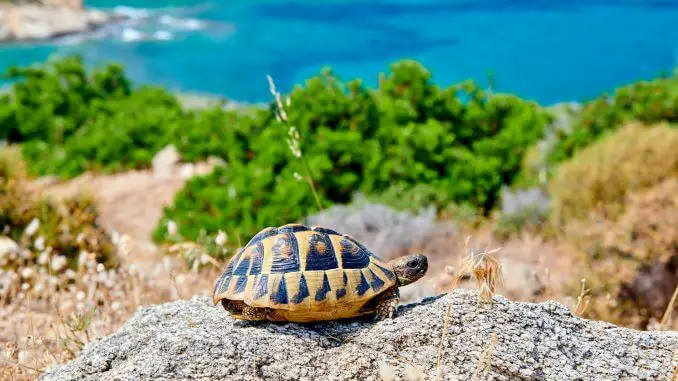
If you know someone with a pet Turtle, chances are that it’s a Box Turtle.
Box Turtles are some of the most common, and the Eastern Box Turtle is a particularly popular choice.
They are known for their beautiful box-like patterns on their dome-shaped shells, and are quite a common summer sight in the forests where they live.
Keeping a Box Turtle is a much bigger commitment than you might think – do you think you are ready for one? Read on to see if this is the right choice for your garden pond or paludarium.
TABLE OF CONTENTS
Eastern Box Turtle Facts & Overview
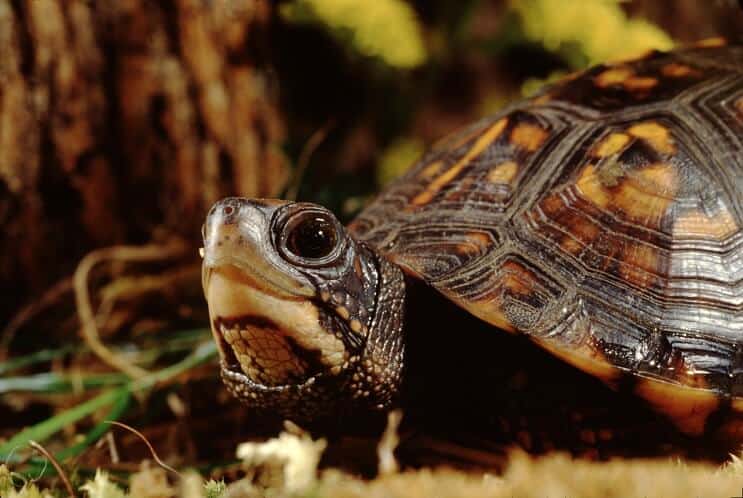
| Category | Rating |
| Care Level: | Advanced |
| Temperament: | Peaceful |
| Color Form: | Brown or black, with yellow, red, or orange speckles |
| Lifespan: | 30-40 years |
| Size: | 4-6 inches |
| Diet: | Omnivore |
| Family: | Emydidae |
| Minimum Tank Size: | 75 gallons |
| Tank Set-Up: | Outdoor enclosure or indoor paludarium |
| Compatibility: | Same species only |
There are six subspecies of Eastern Box Turtles, and they all belong to the Emydidae family.
By far the most popular is the true Eastern Box Turtle (Terrapene carolina carolina), so this guide will focus on this variety.
Coming from Canada and the US East Coast, they can live for 30 to 40 years. But if well cared for, they can live up to 100 years!
In many US states, the sale and trade of this native species is highly regulated. In states where they are not restricted, they can be purchased from reptile breeders for an average of $12 to $20. Within certain states, these Turtles are listed as endangered and cannot be kept without a permit. Many state-based conservation programs exist to protect the wild populations.
You should never buy them online or purchase mail-order hatchlings. The shipping experience can be very distressing for them, and it’s always best to see the Turtle in person to make sure it is healthy.
Make sure that the shell is well-formed and free of cracks or dents. They should be a healthy weight and not have any nasal discharge, puffy eyes, or any other signs of illness.
We will leave you with a few interesting facts about the Eastern Box Turtle to help decide if this is the right pet for you!
- They are North Carolina’s state reptile.
- Box Turtles are named for their ability to form a “box” by closing up the moving hinges on their undershells. They are the only Turtles that are able to do this.
- You can tell how old they are by counting the rings on their shell.
- Box Turtles enjoy cooked chicken and bananas, but these should only be given as an occasional treat.
- They have an internal homing ability, which allows them to find their way home no matter how far away they are! It’s thought they receive information from the Earth’s magnetic field.
Typical Behavior
These Turtles go against the stereotype that they are slow and sluggish.
Eastern Box Turtles are very active and energetic if they have the space to move. They can travel up to 50 meters in one day.
They are most active in the early morning when their environment is damp and moist.
Like other Turtles, they will hide in their shells when they feel scared. Their unique hinged plastrons allow them to completely close up when they need to hide.
They are calm and peaceful and do not like to be handled. If kept with other Box Turtles, they will not interact much except when mating. They do not display aggression towards one-another except in competition for mates.
Most of their time is spent on the terrestrial levels of a paludarium or enclosure, using the water only to cool off if things heat up.
During the day, you will find your Turtles hiding out under logs, in the cover of vegetation, or burrowing into the soil. Just before dawn they will come out looking for some food.
Appearance
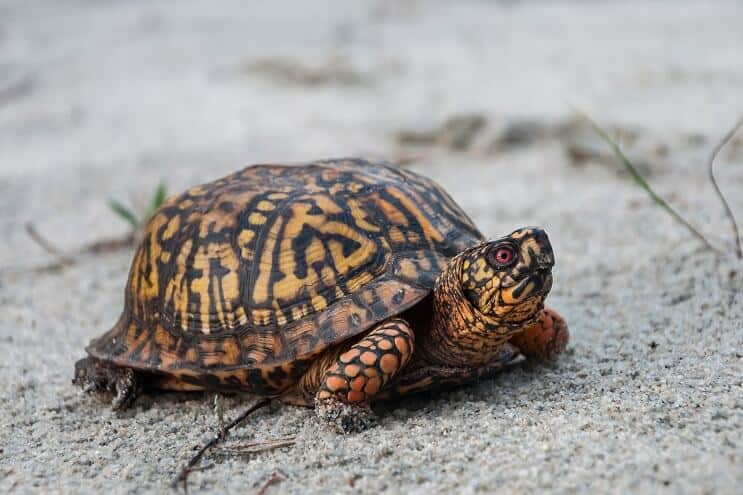
These beautiful Box Turtles come in a variety of colors and patterns.
Generally they are black or dark brown, with yellow underbellies and yellow markings scattered along with their shells and legs. The markings can also be orange, red or deep brown.
Their shells are a dome shape, and the markings appear in a “boxy” pattern of speckles. Males have rounder shells than females.
They range in size from 4 to 6 inches, with males being slightly larger than females. Males have deep red eyes, while females have brown eyes.
Juvenile Turtles have flatter shells and more streamlined bodies for swimming. As adults, they spend more time on land and so have rounder shapes and legs that are more suitable for walking.
They have hooked beaks for eating a variety of prey items.
Baby Eastern Box Turtles
Baby Eastern Box Turtles are very small, they are only about half an inch long when they hatch from their eggs.
They will continue to grow at half an inch per year until they reach maturity at around 5 years old.
At birth, they are brown or black, and their shell is flat. They will develop their iconic speckled patterns as they grow.
Habitat and Tank Conditions
In the temperate United States, Eastern Box Turtles have a very wide habitat range.
They can be found in forests, wetlands, meadows, prairie edges and freshwater lakes, streams, and ponds.
It prefers land to water but enjoys very moist conditions. On cool days, they will climb up on stones and mounds to bask in the sun however, they do not like high temperatures and will hide when sunlight hits them.
They can be found shading themselves under the cover of logs, ferns, and low-growing shrubbery.
Habitat Setup
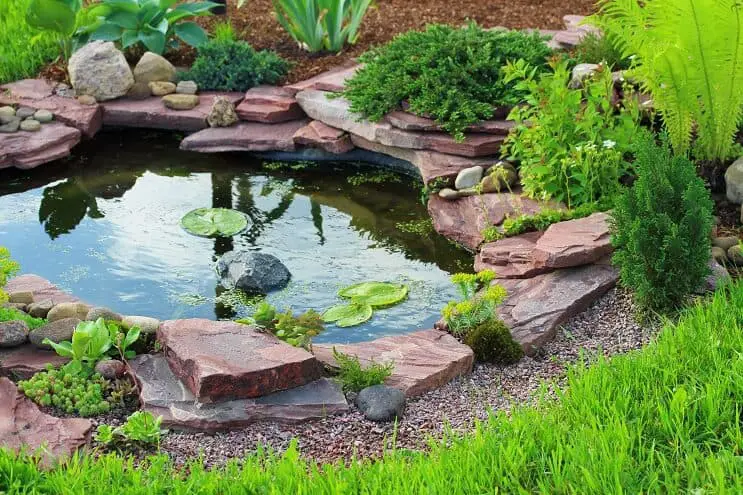
In general, an indoor tank is not an appropriate habitat. It’s better to keep them in an outdoor enclosure or a garden pond, where they will have plenty of space to move around.
An enclosure can be made using a fence or a pen, or even a stack of bricks. It should stand at least 15 inches high and stop them from escaping. Box Turtles do not climb, but they might dig their way out.
They can also live in an outdoor pond setup – a PVC pool is an affordable option.
If you must keep your Turtle in a tank, it should be a long paludarium packed with moist potting soil and freshwater with a pH of 6.0-7.0. The tank must be kept moist and should be misted daily.
They are very messy and will require frequent cleaning and powerful filtration. A canister filter is the best kind of filter for a Box Turtle Tank.
Your Turtle tank should maintain a temperature between 75-80°F. You will need a good aquarium heater to maintain this temperature at night and during the winter months.
Even though they won’t spend much time in the water, the body of water will need to be wide enough for them to swim around in. The water should also be shallow too, it should not reach above their shell.
Turtles that live outdoor can be moved to an indoor enclosure/tank during the winter. They are cold-blooded and cannot regulate their body temperature internally, so must move to sunny and warm spots in order to warm up.
All Turtle tanks require an incandescent heat lamp or UVB lamp for basking. They will want to crawl up on stones and logs to sit under the light and warm themselves up. However, they do not like direct light so will need shading too.
Their habitats should have both terrestrial and aquatic plants. Moisture-retaining mosses such as Peat moss create a great swamp environment, especially when paired with moist soil covered in oak or sassafrass leaves.
In outdoor enclosures, thick prairie grasses and low-lying shrubs provide shade and shelter to hide in. Berry shrubs such as strawberries, blackberries, and huckleberries provide a food source for the Turtles as well as the shading that they need.
Both indoor and outdoor habitats can be furnished with bracken fern, carpet moss, lichens, oak, and cedar logs, as well as floating plants like bladderworts and duckweed.
What Size Aquarium Do They Need?
The minimum size tank for an Eastern box Turtle is 75 gallons.
An outdoor enclosure/pond should be at least 3 feet by 2 feet, with a depth of 15 to 30 inches.
Allow another 40 to 60 gallons of tank space for each additional Turtle.
Tank Mates
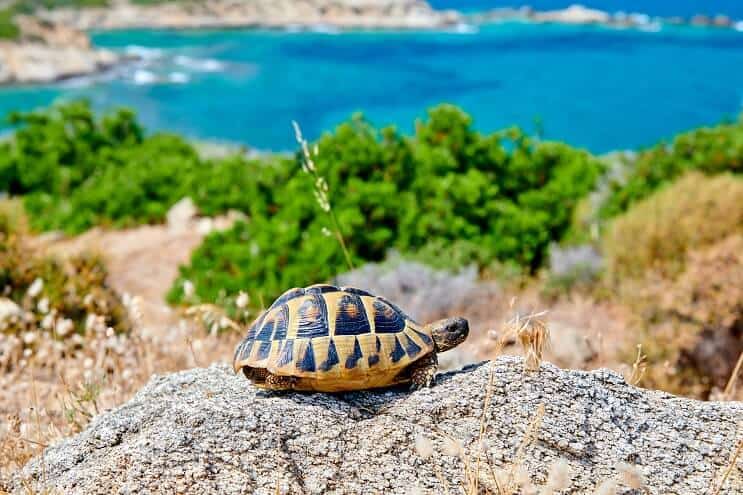
In the wild, Eastern Box Turtles live with other Turtle species, including three-toed and Florida Box Turtles. They also co-habitate with other forest dwelling Turtles such as Bog and Mud Turtles, and wetland species like the Eastern Painted Turtle.
They can be found in swamps and wetlands, alongside freshwater Minnows, Salamanders, and Green, Carpenter, and Leopard Frogs.
However, they are not very compatible with other animals in a captive setting.
Eastern Box Turtles will eat just about anything, including any fish, amphibians, or freshwater invertebrates you might put in their tanks. Keeping them with frogs may also expose them to the fatal ranavirus.
They should not be mixed with other species or subspecies of Turtles, as they can spread disease and infection to one another. An illness that may not affect an Ornate Box Turtle may affect an Eastern Box Turtle, or vice-versa.
It’s best to keep them on their own, or with a small group of other Eastern Box Turtles.
Keeping Eastern Box Turtles Together
Eastern Box Turtles can be kept together in groups of no more than 4 or 5.
The male-to-female ratio of your group should be even, or the females should outnumber the males. Too many males will result in aggressive behavior.
Some states place restrictions on how many you can keep, so be sure to check your State’s regulations if you plan to keep more than one.
Diet
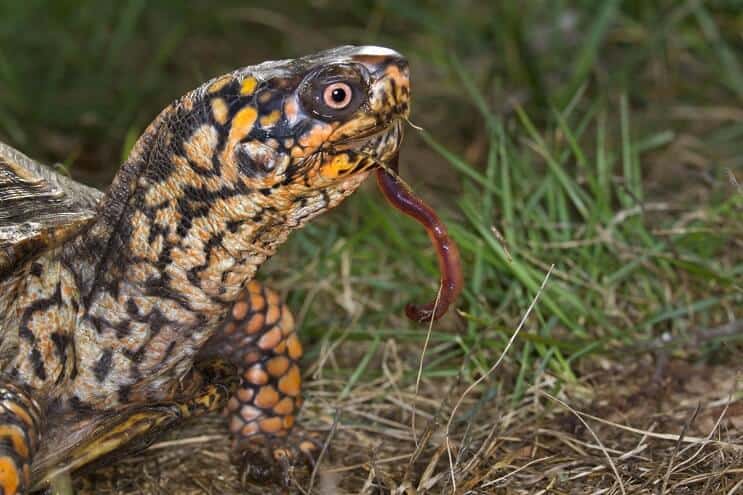
Eastern Box Turtles will eat just about anything.
In the wild, they come out early morning to eat slugs and earthworms. They will also eat fish, insects, amphibians, and even baby mice. They also love wild fruits and veggies that grow in their habitats, including wild strawberries and cranberries.
It is important to give your Turtle a varied diet so they get all the nutrients they would get in the wild.
You can provide wild-caught worms, slugs, and snails from your own garden or backyard. Just be sure you don’t give them anything from an area that has been chemically treated.
Mealworms, crickets, and cockroaches are also ideal.
Turtles love garden fruits and veggies. They will eat strawberries, blueberries, lettuce, and carrots. You can even grow these plants near an outdoor enclosure!
They should be given a calcium supplement to keep their shells healthy and strong.
As for when to feed them, they should be fed just before dawn. They should be fed a minimum of 3 times a week, between 4 and 6 in the morning.
Care
Like many other Turtles, Eastern Box Turtles can carry salmonella. This is a bacterial infection that does not affect them but can be transmitted to humans.
To prevent salmonella, you should always wash your hands after handling them or cleaning the enclosure. Never allow them to crawl on countertops or tables.
They can also transmit bacterial infections to one another. This commonly occurs in overcrowded tanks or when Turtles of different species are kept together.
Signs of illness include red or puffy eyes, sudden or excessive weight loss, nasal discharge, and decreased activity and appetite. You must find a veterinarian that specializes in reptiles to treat your Box Turtle – a regular dog or cat vet isn’t going to cut it.
In the winter, you might want to let your Turtle hibernate as it would in the wild.
They must be kept in a special hibernaculum filled with 4 to 8 inches of moist potting soil. They should be placed in an area where they will not be disturbed.
Your Turtle should be checked on every 2 to 4 weeks for the duration of hibernation. Watch for excessive weight loss or other signs of illness.
Summary
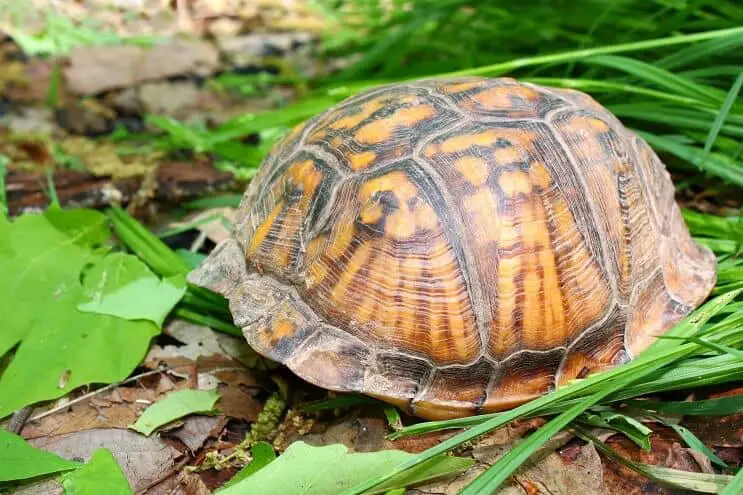
Eastern Box Turtles are unique little pets, but the decision to keep one should not be taken lightly.
Their intensive and highly specialized care requirements mean that they are not good pets for children or inexperienced keepers.
You will need a lot of space, time and energy to dedicate to these Turtles if you want to take one on.
Above all make sure that you are ready for a lifelong commitment. And of course, make sure that you are allowed to keep one in your area.
If you have kept an Eastern Box Turtle before, what was your most successful habitat set-up?

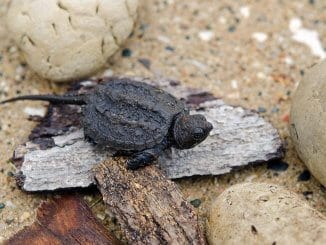

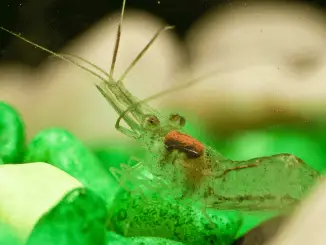
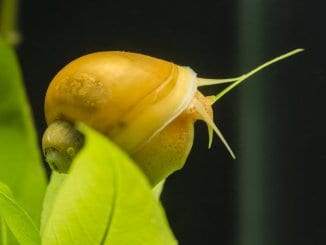
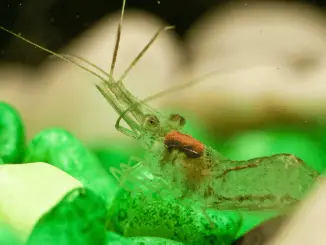

We have two box turtles in an outdoor habitat 12 by 30 with a solid 6 foot fence.
It has trees and shrubs and a small sunken bird bath. We are getting ready to
prepare an area for them for winter. They are very active and good eaters.
Any pointers?